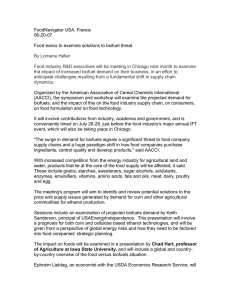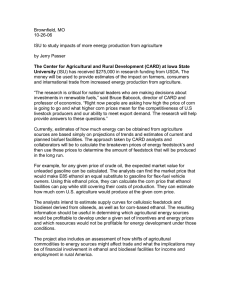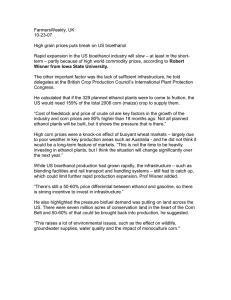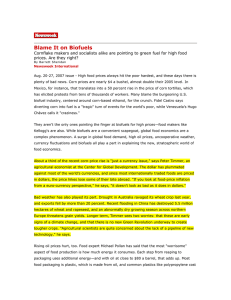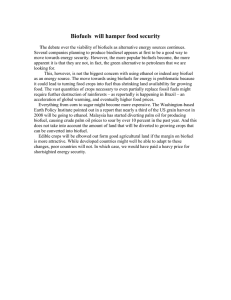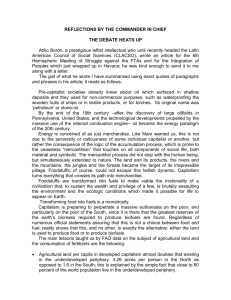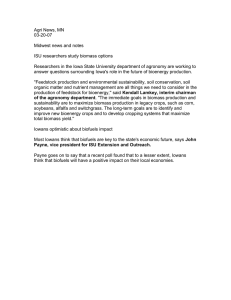Environmental Impacts of Emerging Biomass Feedstock Markets:
advertisement
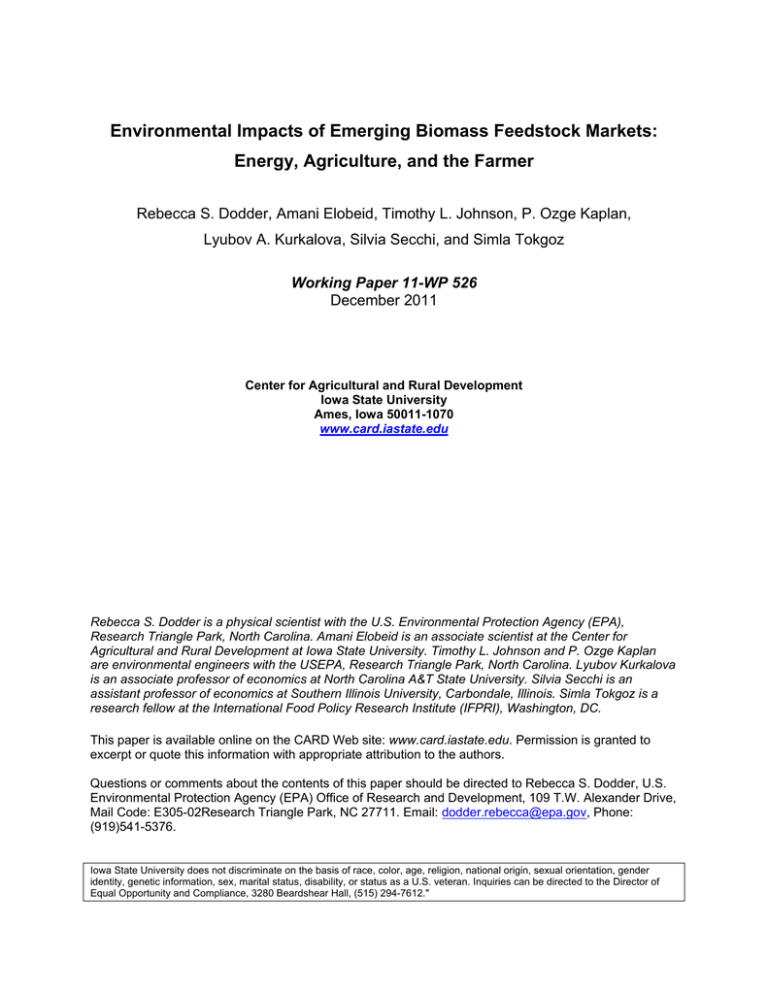
Environmental Impacts of Emerging Biomass Feedstock Markets: Energy, Agriculture, and the Farmer Rebecca S. Dodder, Amani Elobeid, Timothy L. Johnson, P. Ozge Kaplan, Lyubov A. Kurkalova, Silvia Secchi, and Simla Tokgoz Working Paper 11-WP 526 December 2011 Center for Agricultural and Rural Development Iowa State University Ames, Iowa 50011-1070 www.card.iastate.edu Rebecca S. Dodder is a physical scientist with the U.S. Environmental Protection Agency (EPA), Research Triangle Park, North Carolina. Amani Elobeid is an associate scientist at the Center for Agricultural and Rural Development at Iowa State University. Timothy L. Johnson and P. Ozge Kaplan are environmental engineers with the USEPA, Research Triangle Park, North Carolina. Lyubov Kurkalova is an associate professor of economics at North Carolina A&T State University. Silvia Secchi is an assistant professor of economics at Southern Illinois University, Carbondale, Illinois. Simla Tokgoz is a research fellow at the International Food Policy Research Institute (IFPRI), Washington, DC. This paper is available online on the CARD Web site: www.card.iastate.edu. Permission is granted to excerpt or quote this information with appropriate attribution to the authors. Questions or comments about the contents of this paper should be directed to Rebecca S. Dodder, U.S. Environmental Protection Agency (EPA) Office of Research and Development, 109 T.W. Alexander Drive, Mail Code: E305-02Research Triangle Park, NC 27711. Email: dodder.rebecca@epa.gov, Phone: (919)541-5376. Iowa State University does not discriminate on the basis of race, color, age, religion, national origin, sexual orientation, gender identity, genetic information, sex, marital status, disability, or status as a U.S. veteran. Inquiries can be directed to the Director of Equal Opportunity and Compliance, 3280 Beardshear Hall, (515) 294-7612." Environmental impacts of emerging biomass feedstock markets: energy, agriculture, and the farmer Abstract The tighter linkages between energy and crop markets due to recent climate and energy legislation in the US have large potential environmental impacts beyond carbon sequestration and climate mitigation. These range from effects on water quality and quantity, soil erosion, habitat and biodiversity preservation. These impacts are very location and management-decision specific, as they are the product of atomistic decisions and depend on soil and landscape specific variables. In order to fully understand the effects of biomass markets, the new and stronger linkages and feedback effects between national- and global-scale energy and commodity markets must be properly understood and identified using an integrated perspective. We discuss the various interactions between agricultural and energy markets and their environmental impacts for existing biomass crops and detail how these interactions may be strengthened with the emergence of corn stover as a second generation biofuel feedstock. The tighter coupling of land use and management and energy systems needs to be accounted for to ensure that we have accurate indicators of the sustainability of biomass as an energy resource. Keywords Energy and Commodity markets linkages, Integrated energy system assessment, Environmental impacts, Biofuels. Introduction The recent growth in biofuels production from agricultural crops—ranging from corn and soybeans to sugarcane and palm oil—has spurred markets for biomass feedstocks and created new linkages between agricultural and energy markets. These market dynamics bring with them the potential for major impacts on ecosystems. At the global scale, a key example is the debate regarding biofuel’s climate impact via international indirect land use change, the argument being that agricultural market forces could lead to land conversion worldwide – from forest and grassland to cropland – that would lead to the release of carbon from existing ecosystems (Fargione, Hill et al. 2008; Searchinger, Heimlich et al. 2008; Melillo, Reilly et al. 2009). While global-level analyses have focused on broad climate impacts, field- and watershed-scale studies have independently examined the range of domestic environmental and ecosystem impacts from both land-use change and intensification of existing cropland due to biofuel production. These impacts include soil erosion, nitrate and phosphorus loss, and air quality degradation, 1 among others (Robertson, Dale et al. 2008). Recent studies also highlight local impacts on water supply and quality (Dominguez-Faus, Powers et al. 2009), the consequences of crop residue removal for ecosystem services (Karlen, Lal et al. 2009), and risk and opportunities for biodiversity conversation (Fletcher, Robertson et al.). Ultimately, farm-level decisions about crops and management practices will respond to the behavior of increasingly coupled global agricultural and energy markets. Therefore, we first need to understand the linkages between national- and global-scale markets, and the heterogeneous local environmental impacts of biomass production. Failure to account for the resulting field- and watershed-scale environmental impacts may lead to an overstatement of the sustainability of using biomass as an energy resource. As Figure 1 illustrates, an integrated perspective allows us to account for: (1) the linkages between agricultural and energy markets, (2) the impacts of these market dynamics on farm-level decision making, (3) the effects of farm-level land management decisions on the environment, and (4) the lack of existing market-based feedbacks from the environmental impacts of land management at a field scale to these macro-level drivers. We first discuss these linkages in more detail, and then use a specific feedstock corn stover - to illustrate why such linkages must be considered in order to understand the challenges of emerging biomass feedstock markets. We chose corn stover because it can be harvested with existing equipment and, unlike dedicated biomass crops, it is an annual crop and it is associated with the production of a grain – a technology that farmers are very familiar with. Therefore, corn stover is likely to be an important early second generation feedstock for the production of advanced biofuels. 2 Figure 1. Linkages between agricultural and energy markets and their effects on field-level decision making. Agricultural and Energy Interactions Macro-level market linkages Energy market dynamics, particularly fluctuations in petroleum and natural gas prices, have long affected the profitability of agricultural production (Figure 1, link 1).1 With increasing biofuels consumption, agricultural commodities are becoming important energy feedstocks (link 2), and variations in agricultural output and prices now influence the market for transportation fuels (link 3), via the market for biofuels (National Renewable Energy Laboratory 2008; Du and Hayes 2009). Driven by the renewable fuel standard programs (RFS and RFS2) originating under the Energy Policy Act of 2005 and the Energy Independence and Security Act of 2007 (EISA), the share of U.S. corn production supplying the ethanol market has grown from 7.5% in 2001 to 23.2% in 2008 (U.S. Department of Agriculture 2011) (U.S. Department of Agriculture 2010) . This diversion of corn from export markets has had likely impacts on global food prices (Brown, Hintermann et al. 2009) (link 4). Although ethanol from corn will continue to 1 Note: all referenced links and boxes refer to Figure 1. 3 be a significant share of biofuel production, RFS2 sets specific and increasing targets for advanced biofuels such as cellulosic ethanol. The use of agricultural residues will further tighten the coupling between agricultural and energy markets. One starting point to understand how these biofuel mandates affect existing and emerging biomass feedstock markets is to consider their role in energy system supply and consumption. Feedstock demand is affected by: (a) end-use energy demand, (b) technological change, and (c) energy prices (Figure 1, boxes a, b, and c). Factors include the ability to scale up cost-effective cellulosic ethanol production (box b), build out the distribution infrastructure, and use the ethanol produced (box a), given saturation of the market for E10 (10% ethanol by volume) and the limited number of flex-fuel vehicles using E85 (85% ethanol) in the current fleet (U.S. Department of Energy 2009). Technological change (box b) will be crucial in determining how easily different biomass-based fuels and energy can be integrated into the existing energy system, especially potential “drop-in” fuels (e.g., green diesel) that do not require major downstream changes in infrastructure or turnover in existing vehicle fleets. Finally, energy prices ultimately determine biofuels’ competitiveness with fossil fuels (box c), as will be discussed in more depth below. While an energy system perspective provides insights into demand for biomass, in isolation it ignores fundamental drivers affecting feedstock supplies and prices. In the long run, for instance, increased demand (and therefore prices) for agricultural commodities might alter both global agricultural trends, like crop yield and land use changes (link 4), and local production practices, including crop rotation and land management decisions (link 5). Failing to capture these drivers for biomass, and the feedback from energy prices to agricultural production, may produce misleading feedstock supply estimates. Likewise, the availability of land for feedstock production, which is finite, will limit the extent to which biomass feedstocks displace conventional energy resources (box c). Complementary insights from an agricultural market perspective are needed to address these limitations. Energy prices can influence commodity production decisions and also market competitiveness of various biofuels. Higher energy prices, for instance, increase production costs for agricultural commodities and, in turn, their prices. Since direct on-farm energy use is an important agricultural input, production decisions are sensitive to the prices of gasoline, diesel, natural gas, and liquefied petroleum gas (link 6). Likewise, nitrogen fertilizers couple agricultural production costs to the price of natural gas. Natural gas is the main input to ammonia production, and in turn, to nitrogen fertilizers, and natural gas prices will therefore affect the prices and supply of fertilizers (Huang 2007) (link 7). Increases in fertilizer prices, 4 which account for nearly a third of the cost of growing corn (Foreman 2006), will then increase production costs for agricultural commodities (link 8). The same holds true for residues, when nutrient replacement is required after residue removal. All else being equal, higher energy prices increase the competitiveness of the biofuels sector (link 3) and increase competition for agricultural commodities, establishing a price floor for these crops (link 2) (Tokgoz, Elobeid et al. 2007; Hayes, Babcock et al. 2009). Yet the higher demand for agricultural crops utilized for producing biofuels increases crop prices – a major component of biofuel production costs. To maintain their competitiveness in the energy markets, these feedstock prices cannot increase faster than energy prices. This in effect provides a price ceiling for agricultural feedstocks for biofuels (Schmidhuber 2006). Not accounting for these feedbacks leads to an overestimation of the impact of energy prices on biofuel production. Agricultural market analyses, however, typically treat energy prices as exogenous, such that changes in agriculture have no impact on energy markets. On the supply side, biofuel production is assumed to depend primarily on net operating margins to refiners, which are a function of feedstock, biofuel, and coproduct prices. Biomass feedstock production is determined by farmers’ expected net returns, which are driven by feedstock prices, as well as the cost of production (including energy) and comparative net returns for other competing crops/feedstocks that the farmer could grow. A narrow agricultural market perspective, therefore, has difficulty capturing the impact that biofuels have on the supply of and demand for energy substitutes and the resulting feedback to agricultural markets. Yet, as discussed above, increased biofuel production can move energy prices, and to the extent that higher biofuel volumes lower fuel prices, two countervailing effects occur. First, lower fuel prices reduce the cost of agricultural production (input cost reduction effect) (link 1) and second, they make biofuels less competitive (substitute output price reduction effect) (link 3) (Hayes, Babcock et al. 2009). The net impact will depend on the relative size of each of these effects. This illustrates the complex interactions between agriculture and energy, and how the economic viability of feedstock production and biofuel production are interdependent. While our discussion of the links between energy, crop production and the environment focuses on U.S. current biofuel technologies, the same issues have arisen, mutatis mutandis, in Brazil in relation to sugarcane ethanol, and in Europe (particularly Germany) through the use of domestic canola and imported palm oil for biodiesel. Many studies have analyzed the impact of the expansion of biofuels on the U.S. and international agricultural sectors (English, Menard et al. 2005; Schmidhuber 2006; Tokgoz, Elobeid et al. 2007; Gohin 2008; Keeney and Hertel 2009; Hochman, Rajagopal et al. 2010), with the main driver of the expansion of the biofuels market assumed to be either a change in energy markets or 5 various policy initiatives. But, without an integrated agricultural-energy system approach, there could be under- or overestimation of impacts in one sector, since the interaction between markets is now more substantial than before. Field-level response and environmental impacts Since the production of fuels is now partly dependent on land-based technologies, the energy sector is also indirectly more linked to environmental outcomes – not just carbon emissions, which is the focus of the indirect land use change debate – but also water quality and habitat. In the United States, concerns have been expressed about the intensification of production of corn on current cropland, due to potential increases in annual fertilizer requirements for corn-on-corn farming practices and intensive tillage practices resulting in soil erosion. Higher crop prices due to biofuel production have also caused fears that the production of crops will extend to uncropped areas, in particular on land set aside for conservation purposes (Secchi, Gassman et al. 2009). The analysis of these environmental effects requires a disaggregated analysis of where and under which management practices crops are grown, a level of detail that U.S. aggregate crop choice models typically do not have. Planting and management decisions, such as tillage, irrigation, and fertilizer applications, are made on the basis of agricultural commodity and energy prices (links 5, 6 and 8), given local conditions. The relative impact on the optimal levels of inputs may therefore vary substantially across space depending on soiland climate-specific factors, which also drive the agronomic suitability and yield responses of alternative farming practices. Field-level analyses need to be utilized to adequately represent these shifts in farming practices, average productivity, and costs of production (link 9), as well as the associated environmental consequences (link 10). Large-scale models do not always adequately reflect the heterogeneity of the landscape or farm-level management choices associated with that variation, and do not support the need to capture marginal rather than average effects (link 11). For example, while recognizing that the water footprint of biofuel expansion will likely be disproportionately high on marginal lands, the lack of spatially-explicit land use and management models requires making assumptions that the percentage of irrigated acres will not change with increasing biofuels production (Chiu, Walseth et al. 2009; Dominguez-Faus, Powers et al. 2009). As illustrated in Figure 2, the use of fine-grained spatial tools matters because the overall environmental footprint of biofuels requires consideration of a multitude of impacts—carbon loss, soil erosion, nutrient run-off, water consumption, and wildlife habitat degradation—all of which are spatially heterogeneous (Chiu, Walseth et al. 2009). 6 Figure 2. The linchpin: cultivating an Iowa corn field next to a restored wetland. Energy and commodity markets affect both input and output prices for farmers, while farmers’ actions have a variety of environmental impacts, from carbon sequestration to water quality to biodiversity. Emerging Markets for Corn Stover The need for an integrated analytical framework becomes even more apparent when confronting the challenges of using corn stover as a biofuel feedstock. Some studies suggest that the use of agricultural residues will result in little or no competition with food production, and improve the life-cycle greenhouse gas emissions from biofuels (Tilman, Socolow et al. 2009). While the use of residues represent a substantial improvement over the use of food crops in the food-versus-fuel debate, that fact, taken alone, may understate the impact of a crop residue market on the market for the crops themselves, and by extension, on environmental outcomes. A large-scale biomass market using corn stover as a feedstock would increase the monetary returns to corn production, as corn stover harvesting represents essentially a second crop in the corn year. Corn acreage would expand, though average yields would decline as less productive cropland gets drawn into corn production, accelerating a trend already seen with corn grain (Searchinger, Heimlich et al. 2008; Kurkalova, Secchi et al. 2010). The increase in corn acreage may bring about a decrease in corn prices, so that in equilibrium the corn acreage will expand by less than the original increase. Besides these effects 7 mediated by crop and biomass markets, there are others that can only be fully assessed by integrating both energy and environmental considerations in the analysis: 1. Higher corn acreage and corn stover removal rates will require larger fertilizer inputs. As a result, the demand for natural gas to produce nitrogen fertilizers will grow. Tillage may also intensify, therefore increasing demand for diesel (link 12). 2. Given the potential production of advanced biofuels to meet EISA targets and the growing capacity of the corn ethanol industry in the United States, it is crucial to determine whether there will be enough demand for biofuels from the transportation sector to absorb this fast growing supply (link 3). This, in turn, leads to consideration of potential bottlenecks, such as the size of flex-fuel vehicle fleet and the availability of E85 pumps (box a). 3. The extent to which biomass resources can replace fossil fuels is also determined by the limited availability of land for production of food, animal feed, and fuel – especially for feedstocks such as grains and sugarcane, or cellulosic feedstocks such as switchgrass (link 2). With the expansion of the U.S. biofuels sector, this additional pressure on agricultural markets has contributed to higher commodity prices, increasing food insecurity in many regions, including West Africa (Brown, Hintermann et al. 2009) (link 4). Even the use of non-edible biomass such as switchgrass or jatropha will generate competition with other crops for land. This competition, intensified by global population growth, may limit biofuels’ long-term potential to displace fossil fuels. 4. Growth in stover prices will likely draw successively less productive and more environmentally fragile land into production for corn and corn stover (Kurkalova, Secchi et al. 2010) (links 5 and 6). Consequently, as corn stover prices increase, the per acre yield of corn and corn stover will decrease, while undesired environmental impacts such as soil and nutrient losses will escalate (link 10). This could have significant consequences for water quality, particularly without countervailing conservation policies. Although cellulosic ethanol production based on corn stover has a potentially positive overall carbon effect, as it exemplifies an intensification strategy that might help preserve forests and other superior carbon-sequestering land uses, increased stover removal from the field might negatively impact soil carbon in situ (Wilhelm, Johnson et al. 2007). Crop residues play a plethora of environmental roles, and there are critical environmental risks associated with their removal on a massive scale (Karlen, Lal et al. 2009). Even if the overall life-cycle analysis of stover-based biofuels (including indirect land use change effects and soil carbon losses) shows a net reduction in greenhouse gas emissions, other ecosystem services – including soil erosion control, water quality improvements, flood mitigation, nutrient recycling, and improved agronomic productivity – might suffer. 8 Clearly, emerging markets for biomass, and corn stover specifically, mean new challenges for environmental and conservation policy. These challenges will have to rely on limited data and uncertain forecasts, but it will be essential to address them to produce sustainable biofuels. For example, to limit environmental effects, corn stover collection may need to be significantly constrained on some lands. The proportion of environmentally safe residue removal depends the specific metric used and on numerous factors (Wilhelm, Johnson et al. 2004), thus affecting the total supply of this feedstock and its price. Existing conservation policies may be inadequate to ensure actual enforcement of the constraints. Some recent biomass feedstock market assessments assume no or limited corn stover collection on highly erodible land (HEL) due to Conservation Compliance—a federal program providing commodity payments to farmers that implement basic soil conservation practices (English, Menard et al. 2005). However, the biofuels market-induced growth in crop prices may outweigh the subsidies lost by noncompliant farmers, and this conservation program may therefore be ineffective in keeping the HEL out of intensive tillage or excessive corn stover removal. This interdependency between traditional crop prices, energy prices, government subsidies, and biomass collection restrictions, as well as energy, conservation and farm policies, underscores the linkages between traditional agricultural markets, the energy system, farm-level decision making, and emerging markets for biomass feedstocks such as corn stover. Conclusions The forces shaping supply and demand for emerging biomass feedstocks lie at the intersection of macrolevel market dynamics and spatially-explicit field-level decision making. Biofuels policy has already tightened the coupling between agricultural and energy markets for traditional crops like corn, and the expanded use of emerging biomass feedstocks like corn stover will strengthen these linkages. To plan for the emergence of next-generation feedstock markets, policy makers need to understand not only the agricultural-energy market linkages, but also how farm-level production and management decisions respond to changes in both agricultural commodity and energy prices. Those decisions will have important environmental impacts. The absence of market mechanisms that link these environmental impacts to agricultural and energy markets (Figure 1) poses a challenge to policy formulation, as the sustainability consequences of individual management decisions and the environmental performance of biomass feedstock production are key to determining the long-term viability of biofuels and bioenergy. Avoiding unintended consequences of biofuel policies requires a systems approach (Karlen, Lal et al. 2009). The solution proposed by Karlen et al. —a complex landscape system that produces a variety of ecosystem services—requires the integration of geographically-explicit economic and biophysical 9 models, at a scale useful for local and regional decision making. Clearly, effective policy-making will also necessitate the linkage of such integrated models to large scale energy and crop models—the generation of a true system approach. Such an approach will allow for proper accounting of market and non-market feedbacks to inform policy and provide the technical tools to evaluate tradeoffs between biofuels and other energy sources: market costs, energy and carbon balance, and overall environmental footprint. If we want to design effective climate, energy, farm, and conservation policies in the bioenergy era, we need to understand the full ramifications, direct and indirect, of our actions. 10 Acknowledgements This research was supported in part by USDA-CSREES grant 2009-10002-05149, USDA ERS Cooperative Agreements 58-6000-0-0056 and 58-6000-9-0083, EPA Collaborative Agreement CR83371701-1, and NSF CDI CBET-0835607. We thank Rebecca Olson for the graphical support. The views expressed by the authors do not represent the official policy of USDA, EPA, or NSF. References Brown, M. E., B. Hintermann, et al. (2009). "Markets, Climate Change, and Food Security in West Africa." Environmental Science & Technology 43(21): 8016-8020. Chiu, Y.-W., B. Walseth, et al. (2009). "Water Embodied in Bioethanol in the United States." Environmental Science & Technology 43(8): 2688-2692. Dominguez-Faus, R., S. E. Powers, et al. (2009). "The Water Footprint of Biofuels: A Drink or Drive Issue?" Environmental Science & Technology 43(9): 3005-3010. Du, X. and D. J. Hayes (2009). "The impact of ethanol production on US and regional gasoline markets." Energy Policy 37(8): 3227-3234. English, B. C., R. J. Menard, et al. (2005). Economic impacts of ethanol production from maize stover in selected Midwestern states. Agriculture as a Producer and Consumer of Energy. J. Outlaw, K. Collins and J. Duffield. Cambridge, MA, CABI. Fargione, J., J. Hill, et al. (2008). "Land Clearing and the Biofuel Carbon Debt." Science 319(5867): 1235-1238. Fletcher, R. J., B. A. Robertson, et al. "Biodiversity conservation in the era of biofuels: risks and opportunities." Frontiers in Ecology and the Environment 0(0). Foreman, L. (2006). "Characteristics and Productions Costs of U.S. Corn Farms, 2001. Washington, DC: U.S. Department of Agriculture - Economic Research Service (USDAERS)." Gohin, A. (2008). "Impacts of the European Biofuel Policy on the Farm Sector: A General Equilibrium Assessment." Applied Economic Perspectives and Policy 30(4): 623-641. Hayes, D., B. A. Babcock, et al. (2009). "Biofuels: Potential Production Capacity, Effects on Grain and Livestock Sectors, and Implications for Food Prices and Consumers." Journal of Agricultural and Applied Economics 41(2): 465-491. Hochman, G., D. Rajagopal, et al. (2010). "Are Biofuels the Culprit? OPEC, Food, and Fuel." American Economic Review 100(2): 183-187. Huang, W. (2007). "Impact of Rising Natural Gas Prices on U.S. Ammonia Supply." U.S. Department of Agriculture, Economic Research Service. WRS-0702. . Karlen, D. L., R. Lal, et al. (2009). "Crop Residues: The Rest of the Story." Environmental Science & Technology 43(21): 8011-8015. Keeney, R. and T. Hertel (2009). "The Indirect Land Use Impacts of United States Biofuel Policies: The Importance of Acreage, Yield, and Bilateral Trade Responses." American Journal of Agricultural Economics 91: 895-909. 11 Kurkalova, L. A., S. Secchi, et al. (2010). Corn Stover Harvesting: Potential Supply and Water Quality Implications. Handbook of Bioenergy Economics and Policy. M. Khanna, J. Scheffran and D. Zilberman, Springer New York. 33: 307-323. Melillo, J. M., J. M. Reilly, et al. (2009). "Indirect Emissions from Biofuels: How Important?" Science 326(5958): 1397-1399. National Renewable Energy Laboratory (2008). The Impact of Ethanol Blending on U.S. Gasoline Prices. Subcontract Report NREL/SR-670-44517. Robertson, G. P., V. H. Dale, et al. (2008). "AGRICULTURE: Sustainable Biofuels Redux." Science 322(5898): 49-50. Schmidhuber, J. (2006). "Impact of an increased biomass use on agricultural markets, prices and food security: a longer-term perspective. Paper presented at a conference organized by Notre Europe, Paris.". Searchinger, T., R. Heimlich, et al. (2008). "Use of U.S. Croplands for Biofuels Increases Greenhouse Gases Through Emissions from Land-Use Change." Science 319(5867): 1238-1240. Secchi, S., P. Gassman, et al. (2009). "Corn-Based Ethanol Production and Environmental Quality: A Case of Iowa and the Conservation Reserve Program." Environmental Management 44(4): 732-744. Tilman, D., R. Socolow, et al. (2009). "Beneficial Biofuels--The Food, Energy, and Environment Trilemma." Science 325(5938): 270-271. Tokgoz, S., A. Elobeid, et al. (2007). "Emerging Biofuels: Outlook of Effects on U.S. Grain, Oilseed, and Livestock Markets. [07-SR 101]. Ames, IA: Center for Agricultural and Rural Development, Iowa State University.". U.S. Department of Agriculture, E. R. S. (2010). Feed Grains Database. Washington, DC, USDA Research Service. U.S. Department of Agriculture, E. R. S. (2011). Feed Grains Database. Washington, DC, USDA Research Service. U.S. Department of Energy (2009). "Annual Energy Outlook 2009 with Projections to 2030. Washington, DC: Energy Information Administration." Wilhelm, W. W., J. M. F. Johnson, et al. (2004). "Crop and Soil Productivity Response to Corn Residue Removal." Agron. J. 96(1): 1-17. Wilhelm, W. W., J. M. F. Johnson, et al. (2007). "Corn Stover to Sustain Soil Organic Carbon Further Constrains Biomass Supply." Agron J 99(6): 1665-1667. 12
